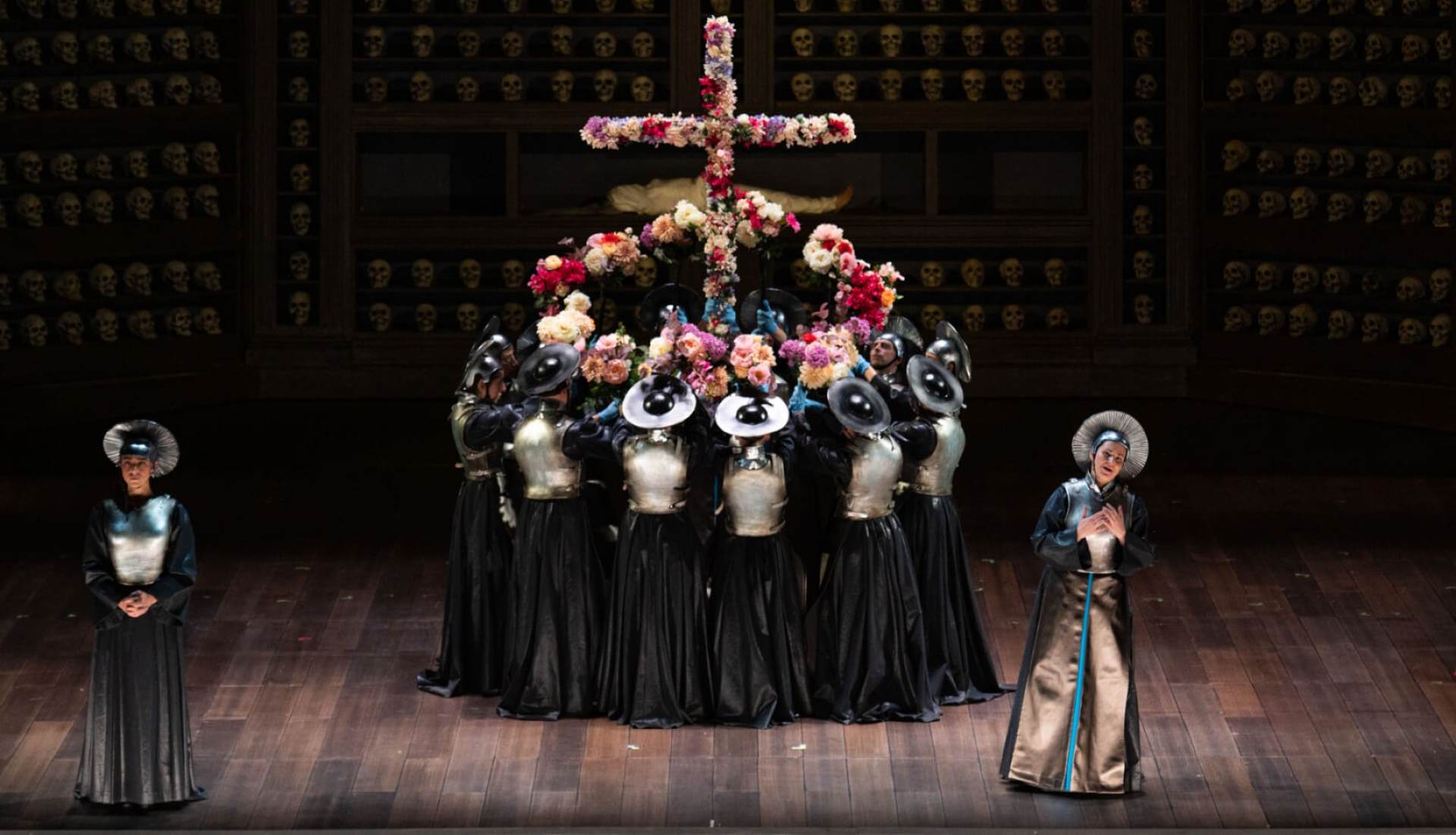DIALOGUES DES CARMELITES Rome 2022 Corinne Winters, Bogdan Volkov, Anna Caterina Antonacci, Ekaterina Gubanova
In this video
DIALOGUES DES CARMELITES by Francis Poulenc
Teatro dell’Opera di Roma, Italy
November 27, 2022
CAST:
MARQUIS DE LA FORCE Jean-François Lapointe
BLANCHE DE LA FORCE Corinne Winters
CHEVALIER DE LA FORCE Bogdan Volkov
MADAME DE CROISSY Anna Caterina Antonacci
MADAME LIDOINE Ewa Vesin
MÈRE MARIE DE L’INCARNATION Ekaterina Gubanova
SOEUR CONSTANCE DE SAINT-DENIS Emöke Baráth
MÈRE JEANNE DE L’ENFANT-JÉSUS Irene Savignano
SOEUR MATHILDE Sara Rocchi
L’AUMÔNIER DU CARMEL Krystian Adam
OFFICIER Roberto Accurso
I COMMISSAIRE William Morgan
LE GEÔLIER / II COMMISSAIRE Alessio Verna
THIERRY /JAVELINOT Andrii Ganchuk
____________________________________________
Conductor: Michele Mariotti
ORCHESTRA del TEATRO DELL’OPERA DI ROMA
CORO del TEATRO DELL’OPERA DI ROMA
CHORUS MASTER Ciro Visco
____________________________________________
DIRECTOR Emma Dante
SET DESIGNER Carmine Maringola
COSTUME DESIGNER Vanessa Sannino
LIGHTING DESIGNER Cristian Zucaro
============================================
Dialogues des Carmélites (French pronunciation: [djalɔɡ de kaʁmelit], Dialogues of the Carmelites), FP 159, is an opera in three acts, divided into twelve scenes with linking orchestral interludes, with music and libretto by Francis Poulenc, completed in 1956. Poulenc wrote the libretto for his second opera after the work of the same name by Georges Bernanos, itself based on The Song at the Scaffold by Gertrud von Le Fort. This is a fictionalized version of the story of the Martyrs of Compiègne, Carmelite nuns who, in 1794 during the closing days of the Reign of Terror during the French Revolution, were guillotined in Paris for refusing to renounce their vocation.
The world première of the opera occurred (in Italian translation) on 26 January 1957 at La Scala in Milan. The première of the French-language version took place in Paris on 21 June 1957. The United States première, in English, followed in San Francisco in September 1957.
Synopsis
Place: Paris and Compiègne, 1789–94 Time: during the French Revolution
Act 1
The opera opens with Marquis and Chevalier de la Force talking about the general unrest in France and their worries about Blanche, at a time when crowds stop carriages in the street and aristocrats are attacked. The pathologically timid Blanche de la Force decides to retreat from the world and enter a Carmelite convent. The Mother Superior informs her that the Carmelite Order is not a refuge; it is the duty of the nuns to guard the Order, not the other way around. In the convent, the chatterbox Sister Constance tells Blanche (to her consternation) that she has had a dream that the two of them will die young together. The prioress, who is dying, commits Blanche to the care of Mother Marie. The Mother Superior passes away in great agony, shouting in her delirium that despite her long years of service to God, He has abandoned her. Blanche and Mother Marie, who witness her death, are shaken.
Act 2
Sister Constance remarks to Blanche that the prioress’ death seemed unworthy of her, and speculates that she had been given the wrong death, as one might be given the wrong coat in a cloakroom. She said that perhaps someone else will find death surprisingly easy. Perhaps we die not for ourselves alone, but for each other.
Blanche’s brother, the Chevalier de la Force, arrives to announce that their father thinks Blanche should withdraw from the convent, since she is not safe there (being both an aristocrat and the member of a religious community, at a time of anti-aristocracy and anti-clericalism in the rising revolutionary tides). Blanche refuses, saying that she has found happiness in the Carmelite Order. Later she admits to Mother Marie that it is fear (or the fear of fear itself, as the Chevalier expresses it) that keeps her from leaving.
The chaplain announces that he has been forbidden to preach (presumably for being a non-juror under the Civil Constitution of the Clergy). The nuns remark on how fear rules the country, and no one has the courage to stand up for the priests. Sister Constance asks, “Are there no men left to come to the aid of the country?” “When priests are lacking, martyrs are superabundant,” replies the new Mother Superior. Mother Marie says that the Carmelites can save France by giving their lives, but the Mother Superior corrects her: it is not permitted to choose to become a martyr; God decides who will be martyred.
A police officer arrives and announces to the community that the Legislative Assembly has nationalized the convent and its property, and the nuns must give up their religious habits. When Mother Marie acquiesces, the officer taunts her for being eager to dress like everyone else. She replies that the nuns will continue to serve, no matter how they are dressed. “The people have no need of servants,” proclaims the officer haughtily. “No, but they have a great need for martyrs,” responds Mother Marie. “In times like these, death is nothing,” he says. “Life is nothing,” she answers, “when it is so debased.”
Act 3
In the absence of the new prioress, Mother Marie proposes that the nuns take a vow of martyrdom. However, all must agree, or Mother Marie will not insist. A secret vote is held; there is one dissenting voice. Sister Constance declares that she was the dissenter, and that she has changed her mind, so the vow can proceed. Blanche runs away from the convent, and Mother Marie goes to look for her, finding her in her father’s library. Her father has been guillotined, and Blanche has been forced to serve her former servants.
The nuns are all arrested and condemned to death, but Mother Marie is away at the time of the arrest. Upon receiving the news, the chaplain tells Mother Marie, when they meet again, that since God has chosen to spare her, she cannot voluntarily become a martyr by joining the others in prison.
At the place of execution, one nun after another stands and slowly processes toward the guillotine, as all sing the “Salve Regina” (“Hail, Holy Queen”). At the last moment, Blanche appears, to Constance’s joy, to join her condemned sisters. Having seen all the other nuns executed, as she mounts the scaffold, Blanche sings the final stanza of the “Veni Creator Spiritus,” “Deo Patri sit gloria…”, the Catholic hymn traditionally used when taking vows in a religious community and offering one’s life to God.
Quoted from Wikipedia






































